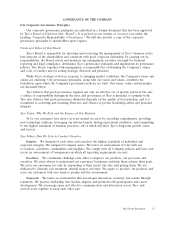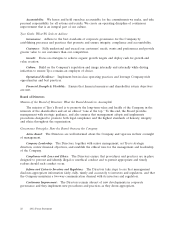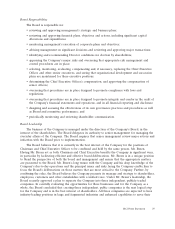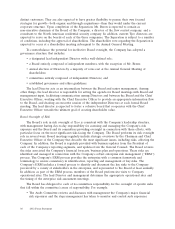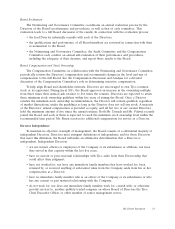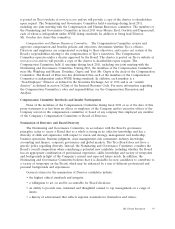ADT 2011 Annual Report Download - page 44
Download and view the complete annual report
Please find page 44 of the 2011 ADT annual report below. You can navigate through the pages in the report by either clicking on the pages listed below, or by using the keyword search tool below to find specific information within the annual report.distinct customers. They are also expected to have greater flexibility to pursue their own focused
strategies for growth—both organic and through acquisitions—than they would under the current
corporate structure. Upon completion of the Separation, Mr. Breen is expected to remain as
non-executive chairman of the Board of the Company, a director of the flow control company, and a
consultant to the North American residential security company. In addition, current Tyco directors are
expected to serve on the boards of each of the three companies. The Separation is subject to a number
of conditions, including the approval of shareholders. The shareholder vote regarding the Separation is
expected to occur at a shareholder meeting subsequent to the Annual General Meeting.
To counterbalance the potential for ineffective Board oversight, the Company has adopted a
governance structure that includes:
• a designated lead independent Director with a well-defined role;
• a Board entirely composed of independent members, with the exception of Mr. Breen;
• annual election of Directors by a majority of votes cast at the Annual General Meeting of
shareholders;
• committees entirely composed of independent Directors; and
• established governance and ethics guidelines.
The lead Director acts as an intermediary between the Board and senior management. Among
other things, the lead director is responsible for setting the agenda for Board meetings with Board and
management input, facilitating communication among Directors and between the Board and the Chief
Executive Officer, working with the Chief Executive Officer to provide an appropriate information flow
to the Board, and chairing an executive session of the independent Directors at each formal Board
meeting. The lead director is expected to foster a cohesive board that cooperates with the Chief
Executive Officer towards the ultimate goal of creating shareholder value.
Board Oversight of Risk
The Board’s role in risk oversight at Tyco is consistent with the Company’s leadership structure,
with management having day-to-day responsibility for assessing and managing the Company’s risk
exposure and the Board and its committees providing oversight in connection with those efforts, with
particular focus on the most significant risks facing the Company. The Board performs its risk oversight
role in several ways. Board meetings regularly include strategic overviews by the Chairman and Chief
Executive Officer of the Company that describe the most significant issues, including risks, affecting the
Company. In addition, the Board is regularly provided with business updates from the President of
each of the Company’s reporting segments, and updates from the General Counsel. The Board reviews
the risks associated the Company’s financial forecasts, business plan and operations. These risks are
identified and managed in connection with the Company’s robust enterprise risk management (‘‘ERM’’)
process. The Company’s ERM process provides the enterprise with a common framework and
terminology to ensure consistency in identification, reporting and management of key risks. The
Company’s ERM includes a formal process to identify and document the key risks to the Company
perceived by a variety of stakeholders in the enterprise, and is presented to the Board at least annually.
In addition, as part of the ERM process, members of the Board perform site visits to Company
operational sites. The lead Director and management determine the appropriate operational sites and
the timing of the enterprise risk assessment meetings.
The Board has delegated to each of its committees responsibility for the oversight of specific risks
that fall within the committee’s areas of responsibility. For example:
• The Audit Committee reviews and discusses with management the Company’s major financial
risk exposures and the steps management has taken to monitor and control such exposures;
30 2012 Proxy Statement









